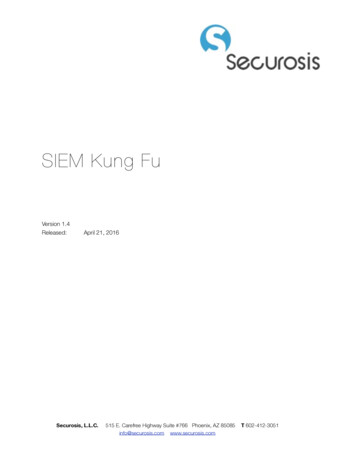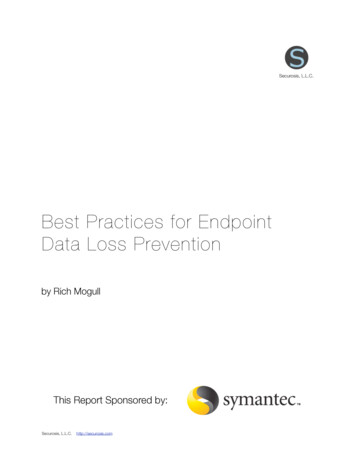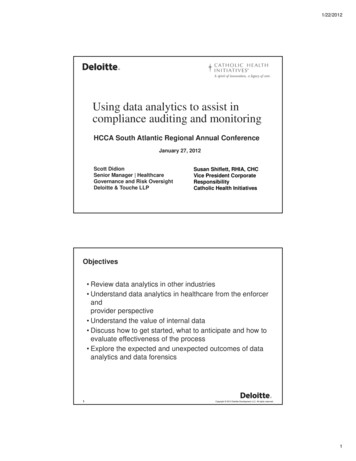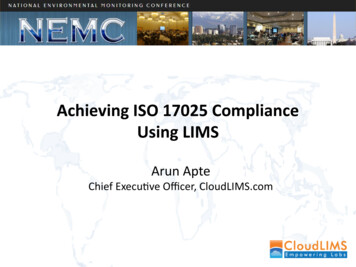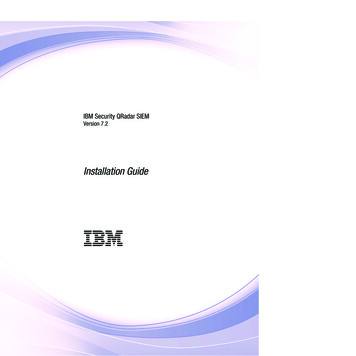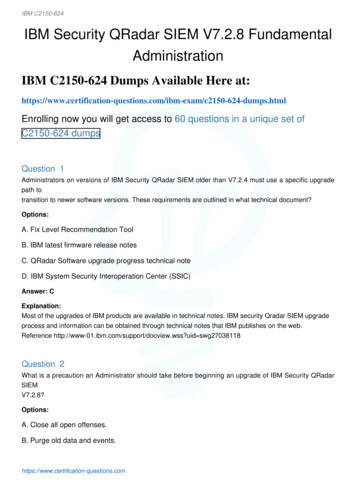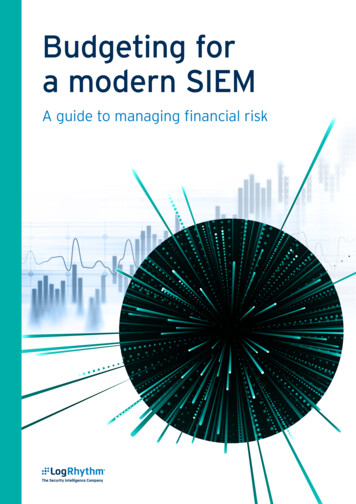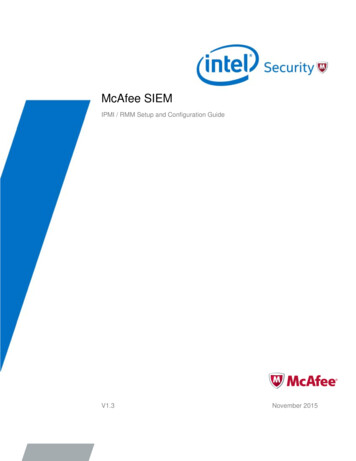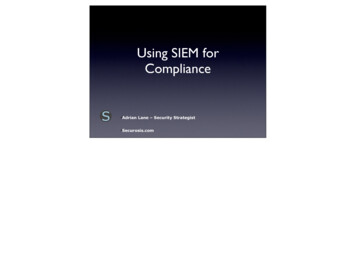
Transcription
Using SIEM forCompliance Adrian Lane – Security Strategist Securosis.com
Overview SIM/SEM Introduction Compliance Initiatives Implementation Examples Tips Other Considerations
Evolution of Terminology SIM – System* Information Management SEM - Security Event Management NBA – Network Based Analysis Log Management – Log file capture & storage SIEM - SIM & SEM3
SIEM: What is it? Diverse Data Collection Aggregation & Normalization Correlation & Analysis Reporting Workflow & Integration3
SIEM: Data Collection Toolkit System logs & files Device logs Network activity Transactions fromapps & database Change logs Discovery
What to do with the Data? The challenge is to map the tools to the complianceinitiative:– What data do I collect?– What am I responsible for keeping?– How do I implement controls?– What reports do I need to produce?– How do I react to events?
SIEM & Compliance: Compliance with what? Regulatory & industry– SOX / PCAOB– FISMA Company–––––Internal auditBusiness process analysisSecurityPrivacy policiesControl frameworks– PCI / DSS– HIPAA– FERPARewriteSecurity ManagementSecurity management includes risk management, information security policies, procedures, standards, guidelines, baselines, information classification, security organization, and security education. These core components serveas the foundation of a corporation’s security program. The crux of security, and a security program, is to protect the company’s assets. A risk analysis will identify these assets, discover the threats that put them at risk, and estimatethe possible damage and potential loss a company could endure if any of these threats become real. The results of the risk analysis help management construct a budget with the necessary funds to protect the recognized assetsfrom their identified threats and develop applicable security policies that provide direction for security activities. Security education takes this information to each and every employee within the company so that everyone is properlyinformed and can more easily work toward the same security goals.Security management has changed over the years because networked environments, computers, and the applications that hold information have changed. Information used to be held in mainframes, which is a more centralizednetwork structure. The mainframe and management consoles used to access and configure the mainframe were placed in a centralized area instead of the distributed approach we see today. Only certain people were allowedaccess and only a small set of people knew how the mainframe worked, which drastically reduced security risks. Users were able to access information on the mainframe through dumb terminals (they were called this because theyhad little or no logic built into them). This also drastically reduced the need for strict security controls to be put into place. However, the computing society did not stay in this type of architecture. Now most networks are filled withpersonal computers that have advanced logic and processing power, users know enough about the systems to be dangerous, and the information is not centralized within one “glass house.” Instead, the information lives on servers,workstations, and other networks. Information passes over wires and airways at a rate that was not even conceived of 10 to 15 years ago.The Internet, extranets (business partner networks), and intranets not only make security much more complex, they make security even more critical. The core network architecture has changed from being a stand-alone computingenvironment to a distributed computing environment that has increased exponentially with complexity. Although connecting a network to the Internet adds more functionality and services for the users and gives more visibility of thecompany to the Internet world, it opens the floodgates to potential security risks.Today, a majority of organizations could not function if they lost their computers and computing capabilities. Computers have been integrated into the business and individual daily fabric and would cause great pain and disruption ifthey were suddenly unavailable. As networks and environments have changed, so has the need for security. Security is more than just a firewall and a router with an access list; these systems have to be managed and a big part ofsecurity is the actions of users and the procedures they follow. This brings us to security management practices, which focus on the continual protection of company assets.
SOX Totem Pole of ClaritySarbanesOxleyPCAOBCOSOSOX & ICOFR Executives must tell the truth Prove your financials are accurateAuditing Standard #5 How auditors prove financials are accurate ‘’Cookbook’ on what and how to investigatePeople & Process, not TechnologyCOBIT IT control objectivesProcess and checklist for technologyIT Systems to be queried & monitoredInfrastructureYou & SIEM How the work gets done
IT’s Role in Producing Financial StatementsFinancial summaryreports – ‘Staging’GLSEC ReportsDB transaction logs10-KApplicationsAP/AR10-QNetwork activityOrder Management8KChange logsAccess &identityServers / OSInventory
SOX – The ‘Show Me’ Regulation Your financialstatements areaccurate? Show me! What happened? Explain what shouldnot have happened Reconciliation
Control Examples:Identity Management Objective:Show that all accounts inrelation to financial reportinghave not been altered toallow unwanted access.Check for unreasonablyescalated privileges thatallow access to accountingand reporting functions.Data source:Access &iden8tyCorrespondingguideline:COBIT:AI2.4DS5.3, DS3.5, DS5.4
Examples:Failed Application Use,Failed Application LoginsObjective:Attempted access to financialapplications or reportingsystems should be reviewedfor signs of potential misuse.Failed transactions should beaccounted for, both as anindicator of potential fraud,and as a KPI for efficiency.Data Sources:Access logsApplication logsNetwork activityCorrespondingregula3on:COBIT:DS10.1
Examples:End of Period Adjustments;Prior Period RemediationObjective:Changes to General Ledger,Accounts Payable, AccountsReceivables after the accountperiod need to bedocumented and explained.Alterations and remediationentries need to be providedto auditors.Data Sources:DB transaction LogsApplication logsCorrespondingregula3on:COBIT:AI 2.3PCAOB:Sec8on A‐38
Examples:Transaction Verification (Application Logs,Transaction Logs, Service Accounts)Objective:Data Sources:Access logsProvide an auditor the abilityto review transactions andverify that what should havehappened actually did happen.ApplicationsNetwork activityDB transaction logsReports should provide insightas to the effectiveness andefficiency of the controls.Aggregation of informationfrom multiple points providesproof of activity.Correspondingregula3on:COBIT:DS 3.5, 5.5, 13.3PCAOB:Sec8on 50
Examples: AnomalyDetection & ReportingData Sources:Provide a suitable explanation ofanomalous events, withsufficient detail, proving thatthere are no deficiencies orerrors in transaction reports.Change logsDB transaction logsServers / OSNetwork activityDetection and reporting forsystem outages, databaserestoration, alteration of auditdata collection, failedtransactions and other eventsshould be recorded and reportedto auditors.Correspondingregula3on:COBIT:AI 7.11, DS 4.8, 5.5, 10.1PCAOB:Sec8on 85
PCI DSSSecurity & Privacy Secure Credit CardData Monitor Use of Data Detective Controls
Monitor all Network Accessto Credit Card DataObjective:Monitor all electronic access tocredit card data, not just thenetwork. Watch the use ofservice and admin accounts forobtaining access rights, andmonitor network access and DBtransaction logs to providedetailed access and use reportsof relevant data.Behavioral Monitoring and PolicyDevelopment are very useful infiltering activity records.Data Sources:DB transaction logsAccess logsNetwork activityCorrespondingregula3on:PCI DSS – Req. 10
Audit: Activity Verification &Remediation ReportsObjective:Provide reports that showactivity and summarizenormal use behavior such asupdates to AV.Detailed reports onanomalous events thatindicate fraud or systemmisuse are alsorecommended.Data Sources:Access logsChange LogsNetwork ActivityApplication LogsCorrespondingregula3on:PCI DSS –Requirements5, 6, 7
Other ComplianceRegulations FISMA FIPS FERPA FRCP HIPAA
Examples: Controls,Monitoring & Data RetentionObjective:Data Sources:Discovery and continuousmonitoring of usage of systemsand data; verify compliance ofpolicies. (Example: FISMA,HIPAA)Access logsNetwork activityApplication logsAttempted alterations tostudents records should bereviewed for signs of potentialmisuse. (Example: FERPA)Collect and filter in accordanceto policy and data retentionrequirements. (Example: FRCP)Correspondingregula3on:FISMA – Con8nuous monitoring& system cer8fica8onNIST ‐ SP‐800 series
Tips & Tricks
Tip #1: Canned Compliance Using Canned Reportsand Controls is likewearing someoneelse’s clothes the fitis often poor and thestyle is just not quiteright.
Tip #2: Complete Picture Make sure you areaware of all yourapplications -- or riskmissing the wholepicture. Consider howvirtualization,outsourcing andpartnerships will effectControls and DataCollection.
Tip #3: Normalized Data Use meaningful reportsto balance the need forefficient datacollection & storage.You can normalizerelevant data right outof reports.
Tip #4: Efficiency Remember, this effortis about efficiency &automation. If yourcontrols and reportsare not making yourjob easier, youprobably have thewrong ones.“The brakes on my car don’t makeme go slower, they allow me to gofaster and s7ll maintain control” –UnaRributed.
Tip #5: Get to KnowYour Auditor The auditor can helpyou understand thecompliancerequirements, what isimportant and what isnot.
Tip #6: People & Process Compliance is moreabout people & processthan technology. Process is what youmake it out to be sochoose a process thatworks for yourorganization. Do not forget training!
Additional Recommendations Vulnerability assessment & risk assessment forpreventative controls and configuration management Discovery tools assist with location of assets and data.
SIEM Value Broad array of data collection, analysis, storage andreporting options Excellent for Detective Controls Acceleration of compliance deployment (with vendorcanned reports and controls) Tailored controls of your processes and systems Enhancing the process: Monitor to help discover whatis going on, then adjust reports and data collection Can feed events to other workflow and management
Adrian LaneSecurosis, L.L.C.alane@securosis.comhttp://securosis.comAIM: securosis
You & SIEM Sarbanes-Oxley PCAOB IT Infrastructure ‘’Cookbook’ on what and how to investigate People & Process, not Technology IT control objectives Process and checklist for technology SOX & ICOFR Executives must tell the truth Prove your financials are accurate Auditing Standard #5File Size: 1MBPage Count: 30
